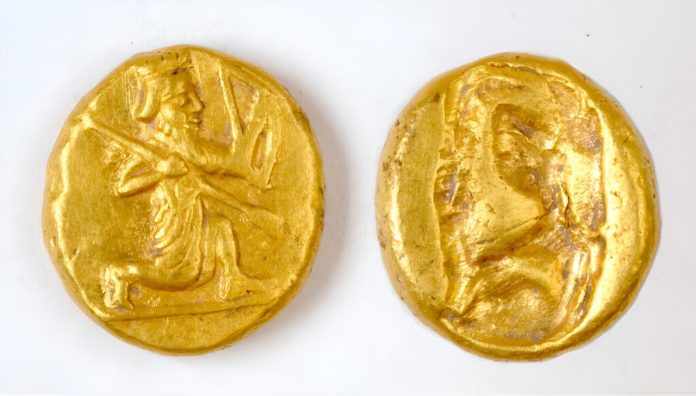
A team of researchers led by a University of Michigan archaeologist has uncovered a treasure of gold coins in the ancient Greek city of Notion in western Turkey.
These coins were likely used to pay mercenary troops and were found buried in a small pot.
The discovery, published in the journal Nature Astronomy, offers new insights into the history and timeline of Persian gold coins.
The gold coins show a figure of a kneeling archer, a characteristic design of the Persian daric.
The daric is a type of gold coin issued by the Persian Empire and probably minted in Sardis, located about 60 miles northeast of Notion.
U-M archaeologist Christopher Ratté, who led the project, explained that finding such a valuable hoard in a controlled excavation is very rare.
Typically, people bury coins with the intention of retrieving them later, so only significant misfortune would leave such a treasure hidden.
The hoard, dated to the 5th century B.C., will provide valuable information about the Persian daric’s history.
Darics were minted from the late 6th century B.C. until the Persian Empire was conquered by Alexander the Great in 330 B.C.
The design of these coins remained mostly unchanged, with only minor stylistic differences.
By analyzing these differences, researchers have tried to arrange the coins in chronological order. The newly discovered hoard, dated by other associated artifacts, will help solidify this timeline.
Andrew Meadows of Oxford University, a former curator of coins at the British Museum and the American Numismatic Society, emphasized the importance of this find. He noted that the archaeological context of the hoard could help fine-tune the chronology of Achaemenid gold coinage, making this a highly significant discovery.
Excavations in Notion began in 2022, and the coins were discovered in 2023. The Turkish Ministry of Culture and Tourism has allowed the findings to be made public.
The best-preserved remains of the city date back to the Hellenistic period (3rd to 1st centuries B.C.), but the excavation of a large courtyard house has shown the city was likely inhabited earlier.
Researchers found fragments of pottery from the 5th century B.C., in walls incorporated into the foundations of the house. In July 2023, excavation beneath one area of the courtyard revealed the hoard of coins, buried in a small pot.
The coins were found in the corner of a room in a structure buried beneath the Hellenistic house. They were likely stored there for safekeeping and never recovered. According to the Greek historian Xenophon, a single daric was equivalent to a soldier’s pay for one month.
Notion was incorporated into the Persian Empire along with other Greek cities on the west coast of Turkey in the mid-6th century B.C. It was freed from Persian rule in the early 5th century B.C., but then reintegrated into the Persian Empire in the early 4th century B.C., remaining under Persian control until Alexander the Great’s conquest in 334 B.C.
Military operations frequently took place around Notion, and these conflicts could have led to the deposition and loss of the hoard. During much of the 5th century B.C., Notion was under Athenian control.
A dramatic episode recorded by the Greek historian Thucydides describes how Persian sympathizers occupied part of Notion with the help of mercenaries, only to be expelled by an Athenian general.
The project is sponsored by the University of Michigan in cooperation with Sinop University and authorized by the Turkish Ministry of Culture and Tourism. Continued excavation and study of the coins, now held at the Ephesus Archaeological Museum in Turkey, will provide further evidence about the date, function, and historical implications of this remarkable find. Researchers hope to clarify the archaeological context of the hoard during the new field season at Notion.



